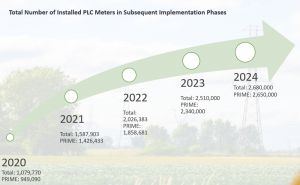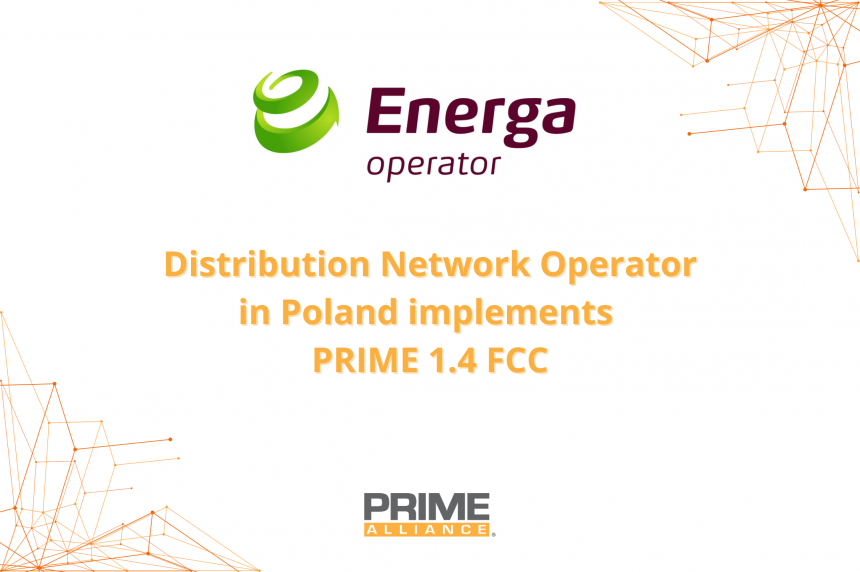 As a part of the ongoing tendering procedures, two main suppliers of the meters were selected: PRIME, i.e. APATOR SA and SAGEMCOM Poland Sp. z o. o. Both manufacturers had to meet specific technical requirements for the products in the purchasing procedure. An important condition for the purchase of remote reading meters was the presentation of a meter sample and a meter sample with a modem for substitute communication and subsequent verification of the verification tranche before mass deliveries of the operation of meters in the distribution network system.
It is worth acknowledging the particular increase of photovoltaic installations throughout recent years, as well as the change in the EMC norm, which affected the growth of the number of recipients electronic devices and resulted in interfering with a CELENEC A, band used to transmit the measurement data. In this regard, ENERGA-OPERATOR SA has become widely utilizing the new PRIME 1.4. standard, with particular emphasis on the use of higher frequency bands. Maintaining communication with the meters and hubs installed in the network that support only PRIME 1.3.6. has become a challenge.
Realization and application of PRIME 1.4. channels 3-8
In order to restrict the implementation costs of PRIME 1.4. FCC and replace the currently utilized PRIME 1.3.6, a new approach has been developed and appended into the meters.
Electric meters, acquired by ENERGA-OPERATOR SA, are equipped with the PRIME 1.4 BC
(with a backward compatibility) in the CELENEC A band – channel 1, as well as a band plan involving a total of three channels (channel 1, channel 6 and channel 4). Moreover, in order to assure enhanced PLC signal in the three-phase meters, three 1-phase PLC couplers switched automatically are required. A choice of the listed channels has been selected based on power grid disturbance examination and test deployments of PRIME 1.4 in various configurations, conducted on the ENERGA-OPERATOR SA network.
Automatic channel selection in the meters, works according to the following procedure:
As a part of the ongoing tendering procedures, two main suppliers of the meters were selected: PRIME, i.e. APATOR SA and SAGEMCOM Poland Sp. z o. o. Both manufacturers had to meet specific technical requirements for the products in the purchasing procedure. An important condition for the purchase of remote reading meters was the presentation of a meter sample and a meter sample with a modem for substitute communication and subsequent verification of the verification tranche before mass deliveries of the operation of meters in the distribution network system.
It is worth acknowledging the particular increase of photovoltaic installations throughout recent years, as well as the change in the EMC norm, which affected the growth of the number of recipients electronic devices and resulted in interfering with a CELENEC A, band used to transmit the measurement data. In this regard, ENERGA-OPERATOR SA has become widely utilizing the new PRIME 1.4. standard, with particular emphasis on the use of higher frequency bands. Maintaining communication with the meters and hubs installed in the network that support only PRIME 1.3.6. has become a challenge.
Realization and application of PRIME 1.4. channels 3-8
In order to restrict the implementation costs of PRIME 1.4. FCC and replace the currently utilized PRIME 1.3.6, a new approach has been developed and appended into the meters.
Electric meters, acquired by ENERGA-OPERATOR SA, are equipped with the PRIME 1.4 BC
(with a backward compatibility) in the CELENEC A band – channel 1, as well as a band plan involving a total of three channels (channel 1, channel 6 and channel 4). Moreover, in order to assure enhanced PLC signal in the three-phase meters, three 1-phase PLC couplers switched automatically are required. A choice of the listed channels has been selected based on power grid disturbance examination and test deployments of PRIME 1.4 in various configurations, conducted on the ENERGA-OPERATOR SA network.
Automatic channel selection in the meters, works according to the following procedure:
- The meter is installed in the network with the usage of PRIME 1.4 BC channel 1,
- The meter verifies whether there is a PLC available on the L1 phase, if communication is not obtained, it switches to the L2 and L3 phases in turn,
- If the meter doesn’t find communication in channel 1 (on any of the phases) it selects the next channel (channel 6) from the band plan, then re-verifies the phases L1, L2, L3 in turn,
- If the meter doesn’t find communication in channel 6 (on any of the phases) it selects the next channel (channel 4) from the band plan, then re-verifies the phases L1, L2, L3 in turn,
- If the meter doesn’t find communication PLC in any of the channels returns to channel 1 and searches the next phases and channels that are in the band plan.
- If the meter has a GSM substitute communication modem, it will switch to GSM when the search in channel 4 is completed. GSM technology is an alternate communication and is used only in 5% of installed meters.

